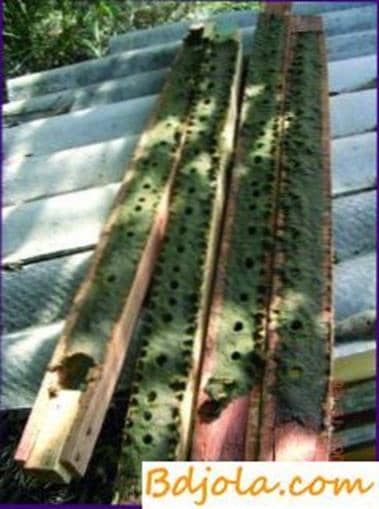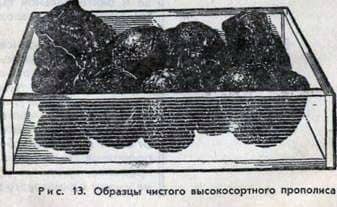Properties of propolis

Propolis (from Greek words: pro-front and polis-city) plays an important role in the life of the bee family. They are reduced by the bees through the hive into the hive.

Fig. 12. An open beehive and a canvas covered with propolis
Propolis bees seal the cracks in the hive, attach the frame hangers to the hive folds, polish the honeycomb cells serving as bins for honey and flower pollen and cradles for the larvae. With propolis, bees immobilize the lizards, snakes, and mice, who have slipped into the beehive and killed by bee venom, thus saving the thousands of beehive population from the unpleasant odor and bacterial flora, preventing decomposition and decay.
Propolis samples from different geographical areas differ not only in color, aroma, but also in chemical composition. This, apparently, depends on the zone and area of propolis harvest. Even samples of propolis from one hive do not have the same chemical composition. Propolis is a rather complex substance containing essential oils, vitamins, and propol ashes-iron, manganese, calcium, aluminum, silicon, vanadium, strontium. Spectral analysis revealed that propolis is an organic compound containing ash components, the volatile ethers of which, most likely, act similarly to phytoncides.
Propolis contains on the average 55% of resins and balms, 10% of fragrant essential oils, 30-35% of wax and 5% of pollen. Specific gravity of propolis 1,113-1,136. The melting point is 80-100 њ C. A wax containing propolis is softer and lighter than natural wax. Coefficient of hardness of propolized wax is 2 times less than even low-quality press wax. Wax mixed with propolis reduces the quality of natural wax and makes it unsuitable for the production of artificial wax.

If you open a beehive on a hot summer day, you can see a brownish-greenish substance with a pleasant resinous smell – this is propolis, or bee glue, as its beekeepers often call it. Some researchers believe that bees harvest from buds of willow, poplar, birch, spruce, fir, pine, horse chestnut, etc., but propolis. But there are data that bees collect it from the buds of various plants, and also use resin from coniferous trees.
Bees are sent for this repair and construction material at 10 am and work until 16 o’clock. Propolis bees are mostly harvested in the fall, when they prepare for winter rest. In spring and summer, when bees are busy collecting nectar and pollen, propolis is very rarely collected. Bees-propolis, flying to the hive, give propolis to beehive bees, which unload it from the pollen baskets, and they again go for bee glue. In each bee family, the collection of propolis employs a small number of bees.
Properties of propolis
